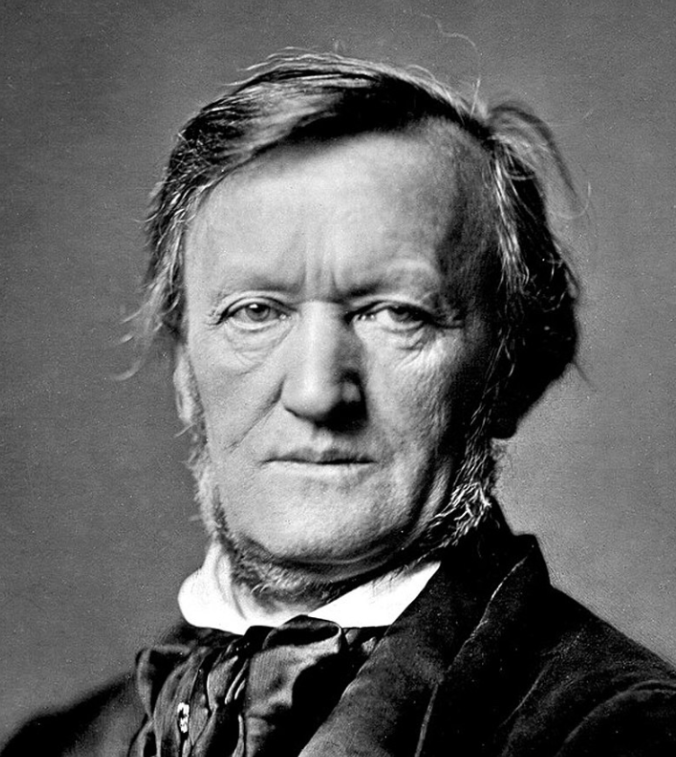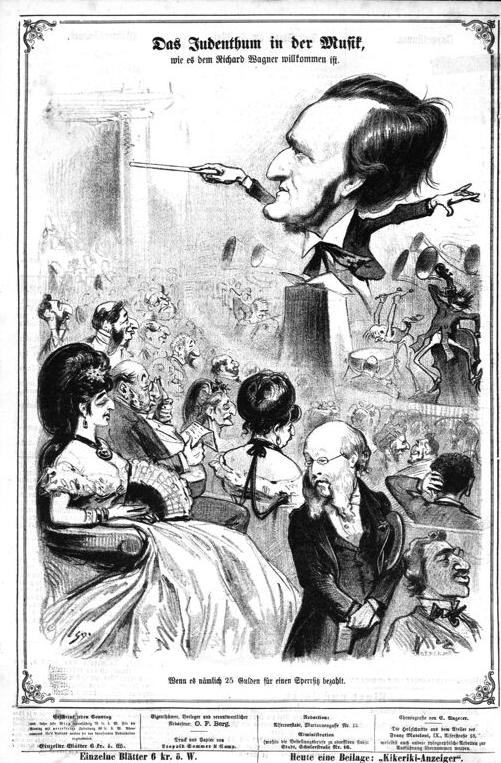
Wagner, Nietzsche and National Socialism
Richard Wagner (1813-1883) remains a controversial figure in the classical music world to this day. Although his revolutionary compositions have earned him a lasting place in the canon, his work is overshadowed by his deeply held anti-Semitic views. The controversy lies primarily with his personal views, due to his outspoken anti-Semitism and the later association of his work with National Socialism.
Meistersinger
Wagner’s anti-Semitism has cast a shadow over his legacy to this day. In his Das Judenthum in der Musik (1850), the composer expressed negative views of his Jewish colleagues, whom he considered responsible for “degradation” of German musical culture. According to Wagner, Jewish musicians would not be able to create authentic German music. Das Judenthum in der Musik (Judaism in music) was not only provocative in its time, but later served as ideological ammunition for the Third Reich’s anti-Semitism. In Israel, there is a de facto ban on the performance of his work.
Is it then still possible to separate Wagner’s artistic achievements from his personal beliefs and the later misuse of his music? Can his works be appreciated for their artistic merit while keeping his anti-Semitism out of the picture?
Übermensch
Wagner’s operas celebrated Germanic myths and fueled nationalism, again themes that resonated with Nazi ideology. Die Meistersinger von Nürnberg (1868) and Der Ring des Nibelungen (1853-1874) were seen as embodying the spirit of German culture. This was particularly to the liking of Adolf Hitler (1889-1945), who was an ardent admirer of Wagner’s music and ideas. He saw Wagner’s operas as a symbol of German cultural superiority. Wagner’s music was frequently played during Nazi meetings and events. The Nazis appropriated the composer’s works to serve their agenda, using his music to evoke a sense of national pride and unity.
Wagner and Nietzsche
Friedrich Nietzsche (1844-1900) who initially sympathized with Wagner, turned away from him partly because of his anti-Semitism. Nietzsche initially admired Wagner for his revolutionary spirit and artistic genius. His essay Die Geburt der Tragödie (1872) refers to Wagner and his influence on art and culture. However, the distance between Nietzsche and Wagner became increasingly distant because of Wagner’s overt anti-Semitism and the way it used his art to promote national and religious themes. Nietzsche felt that Wagner’s later works, such as Parsifal (1882), betrayed the revolutionary ideals he once admired.
Nietzsche’s own contradictory opinion
Despite his criticisms, Nietzsche himself was not necessarily in the clear. Although he sometimes expressed admiration for Jewish virtues, he also made derogatory remarks in his private correspondence and unpublished notes. After his death, Nietzsche’s sister, Elisabeth Förster-Nietzsche (1846-1935), became curator and editor of his manuscripts. She edited his unpublished writings to make them fit better with her German ultra-nationalist ideology. She also rewrote the introduction in a reissue of Also sprach Zarathustra (1896). Nietzsche, who spent his last years in madness, thus also found himself in the throes of fascism and Nazism. Scholars of the twentieth century, such as Walter Kaufmann, R.J. Hollingdale and Georges Bataille, defended Nietzsche against the interpretations, and soon corrected editions of his writings were made available.
Nietzsche contra Wagner
The break with Wagner culminated in his work Nietzsche contra Wagner (1889), in which Nietzsche criticized Wagner’s music and philosophy and expressed his disappointment with Wagner’s perceived weaknesses and religious prejudices. In this critical study, Nietzsche gathered selections from earlier writings to set forth his evolving thoughts on Wagner. His initial admiration of artistic genius and shared philosophical interests, especially for the philosopher Arthur Schopenhauer (1788 – 1860) turned to disappointment because of Wagner’s alleged turn toward Christianity and what Nietzsche saw as a degradation of the artist’s artistic integrity. In the work, he accused Wagner of succumbing to the social and cultural platitudes they once opposed. The critique extended beyond Wagner’s personal choices to his music and its cultural impact. He admired Wagner’s emotional expressiveness, but condemned what he saw as manipulative and regressive elements in Wagner’s later works.

This caricature appeared in 1872 in the satire magazine Kikeriki and mocks how Richard Wagner, despite his criticism of Jews in music, gladly accepted their money. The image shows Wagner as an overly important conductor, while wealthy Jews sit in the audience. The text points out the irony that Wagner has no problem with Jews – as long as they pay for expensive seats. The cartoon shows how Wagner’s attitude was seen as hypocritical even in his time.
Want to read more?
Via Wikipedia read the second edition of Das Judentum in der Musik: https://de.wikisource.org/wiki/Das_Judenthum_in_der_Musik_(1869). Accessed on 9/11/2024.
Article on the banning of Wagner’s music in Israel: https://www.standaard.be/cnt/dmf20120605_00173765. Accessed 9/11/2024.
Article on Wagner and Nietzsche: https://www.filosofie.nl/wagner-u-bent-een-ziekte/. Accessed 9/11/2024.
Article on Wagner and Hitler: https://isgeschiedenis.nl/nieuws/wagner-en-zijn-invloed-op-hitler. 9/11/2024.
Photograph of Richard Wagner in 1871. Source: Wikimedia commons.
Alle auteurs
- DIS
- Advice from the doctor
- African poetry
- AIDS activism and gay emancipation
- Bibliography of Chris
- Bibliography of Olivier
- Biography of Chris
- Biography of Olivier
- Biography of Patrick
- Blogs
- Chris' Stage
- Columns
- Covid
- Dirk van Babylon Newsletter
- Double calling
- Essays
- Fragile light
- Hanna's Mind Wanderings
- Incapacity for work
- Late Pasquino's
- LEIF doctor
- Liechtensteiner
- Medical newsletter
- Memoirs of a general practitioner
- Miguel Molinos
- Moctines
- Musings
- Myriad
- Practice in Erembodegem
- Resignation
- Sleep problems
- Sonnets
- Sprawl Month
- Substance abuse and addiction
- Travel
- Uncategorized
- Vi to
- Vögels
- Voluntary euthanasia
- Weltschmerz
- Wormwood or The dose makes the poison
- kapper
- Advice from the doctor
- African poetry
- AIDS activism and gay emancipation
- Bibliography of Chris
- Bibliography of Olivier
- Biography of Chris
- Biography of Olivier
- Biography of Patrick
- Blogs
- Chris' Stage
- Columns
- Covid
- Dirk van Babylon Newsletter
- Double calling
- Essays
- Fragile light
- Hanna's Mind Wanderings
- Incapacity for work
- Late Pasquino's
- LEIF doctor
- Liechtensteiner
- Medical newsletter
- Memoirs of a general practitioner
- Miguel Molinos
- Moctines
- Musings
- Myriad
- Practice in Erembodegem
- Resignation
- Sleep problems
- Sonnets
- Sprawl Month
- Substance abuse and addiction
- Travel
- Uncategorized
- Vi to
- Vögels
- Voluntary euthanasia
- Weltschmerz
- Wormwood or The dose makes the poison
- Marforio
- Advice from the doctor
- African poetry
- AIDS activism and gay emancipation
- Bibliography of Chris
- Bibliography of Olivier
- Biography of Chris
- Biography of Olivier
- Biography of Patrick
- Blogs
- Chris' Stage
- Columns
- Covid
- Dirk van Babylon Newsletter
- Double calling
- Essays
- Fragile light
- Hanna's Mind Wanderings
- Incapacity for work
- Late Pasquino's
- LEIF doctor
- Liechtensteiner
- Medical newsletter
- Memoirs of a general practitioner
- Miguel Molinos
- Moctines
- Musings
- Myriad
- Practice in Erembodegem
- Resignation
- Sleep problems
- Sonnets
- Sprawl Month
- Substance abuse and addiction
- Travel
- Uncategorized
- Vi to
- Vögels
- Voluntary euthanasia
- Weltschmerz
- Wormwood or The dose makes the poison
- Michiel Hillen
- Advice from the doctor
- African poetry
- AIDS activism and gay emancipation
- Bibliography of Chris
- Bibliography of Olivier
- Biography of Chris
- Biography of Olivier
- Biography of Patrick
- Blogs
- Chris' Stage
- Columns
- Covid
- Dirk van Babylon Newsletter
- Double calling
- Essays
- Fragile light
- Hanna's Mind Wanderings
- Incapacity for work
- Late Pasquino's
- LEIF doctor
- Liechtensteiner
- Medical newsletter
- Memoirs of a general practitioner
- Miguel Molinos
- Moctines
- Musings
- Myriad
- Practice in Erembodegem
- Resignation
- Sleep problems
- Sonnets
- Sprawl Month
- Substance abuse and addiction
- Travel
- Uncategorized
- Vi to
- Vögels
- Voluntary euthanasia
- Weltschmerz
- Wormwood or The dose makes the poison
- Michiel Hillen; Chris Coolsma
- Advice from the doctor
- African poetry
- AIDS activism and gay emancipation
- Bibliography of Chris
- Bibliography of Olivier
- Biography of Chris
- Biography of Olivier
- Biography of Patrick
- Blogs
- Chris' Stage
- Columns
- Covid
- Dirk van Babylon Newsletter
- Double calling
- Essays
- Fragile light
- Hanna's Mind Wanderings
- Incapacity for work
- Late Pasquino's
- LEIF doctor
- Liechtensteiner
- Medical newsletter
- Memoirs of a general practitioner
- Miguel Molinos
- Moctines
- Musings
- Myriad
- Practice in Erembodegem
- Resignation
- Sleep problems
- Sonnets
- Sprawl Month
- Substance abuse and addiction
- Travel
- Uncategorized
- Vi to
- Vögels
- Voluntary euthanasia
- Weltschmerz
- Wormwood or The dose makes the poison
- Olivier Lichtenberg
- Advice from the doctor
- African poetry
- AIDS activism and gay emancipation
- Bibliography of Chris
- Bibliography of Olivier
- Biography of Chris
- Biography of Olivier
- Biography of Patrick
- Blogs
- Chris' Stage
- Columns
- Covid
- Dirk van Babylon Newsletter
- Double calling
- Essays
- Fragile light
- Hanna's Mind Wanderings
- Incapacity for work
- Late Pasquino's
- LEIF doctor
- Liechtensteiner
- Medical newsletter
- Memoirs of a general practitioner
- Miguel Molinos
- Moctines
- Musings
- Myriad
- Practice in Erembodegem
- Resignation
- Sleep problems
- Sonnets
- Sprawl Month
- Substance abuse and addiction
- Travel
- Uncategorized
- Vi to
- Vögels
- Voluntary euthanasia
- Weltschmerz
- Wormwood or The dose makes the poison
- Patrick Bernauw
- Advice from the doctor
- African poetry
- AIDS activism and gay emancipation
- Bibliography of Chris
- Bibliography of Olivier
- Biography of Chris
- Biography of Olivier
- Biography of Patrick
- Blogs
- Chris' Stage
- Columns
- Covid
- Dirk van Babylon Newsletter
- Double calling
- Essays
- Fragile light
- Hanna's Mind Wanderings
- Incapacity for work
- Late Pasquino's
- LEIF doctor
- Liechtensteiner
- Medical newsletter
- Memoirs of a general practitioner
- Miguel Molinos
- Moctines
- Musings
- Myriad
- Practice in Erembodegem
- Resignation
- Sleep problems
- Sonnets
- Sprawl Month
- Substance abuse and addiction
- Travel
- Uncategorized
- Vi to
- Vögels
- Voluntary euthanasia
- Weltschmerz
- Wormwood or The dose makes the poison
- stadsfiguren
- Advice from the doctor
- African poetry
- AIDS activism and gay emancipation
- Bibliography of Chris
- Bibliography of Olivier
- Biography of Chris
- Biography of Olivier
- Biography of Patrick
- Blogs
- Chris' Stage
- Columns
- Covid
- Dirk van Babylon Newsletter
- Double calling
- Essays
- Fragile light
- Hanna's Mind Wanderings
- Incapacity for work
- Late Pasquino's
- LEIF doctor
- Liechtensteiner
- Medical newsletter
- Memoirs of a general practitioner
- Miguel Molinos
- Moctines
- Musings
- Myriad
- Practice in Erembodegem
- Resignation
- Sleep problems
- Sonnets
- Sprawl Month
- Substance abuse and addiction
- Travel
- Uncategorized
- Vi to
- Vögels
- Voluntary euthanasia
- Weltschmerz
- Wormwood or The dose makes the poison
Other works by our writers
- November 2025 (1)
- August 2025 (1)
- July 2025 (2)
- March 2025 (3)
- December 2024 (10)
- November 2024 (6)
- October 2024 (3)
- February 2021 (3)
- January 2021 (5)
No comments have been posted yet!